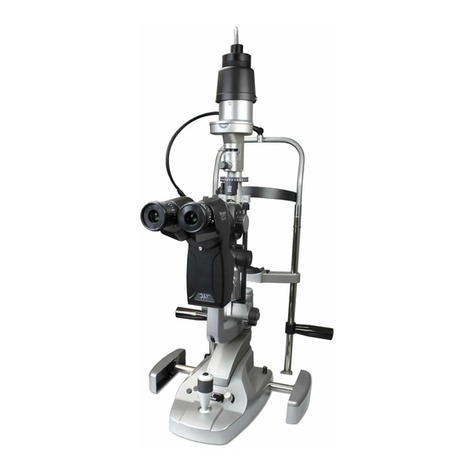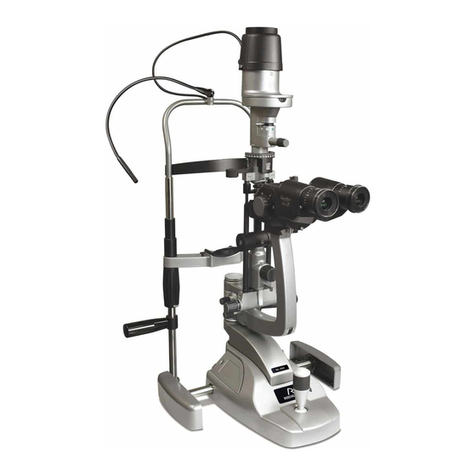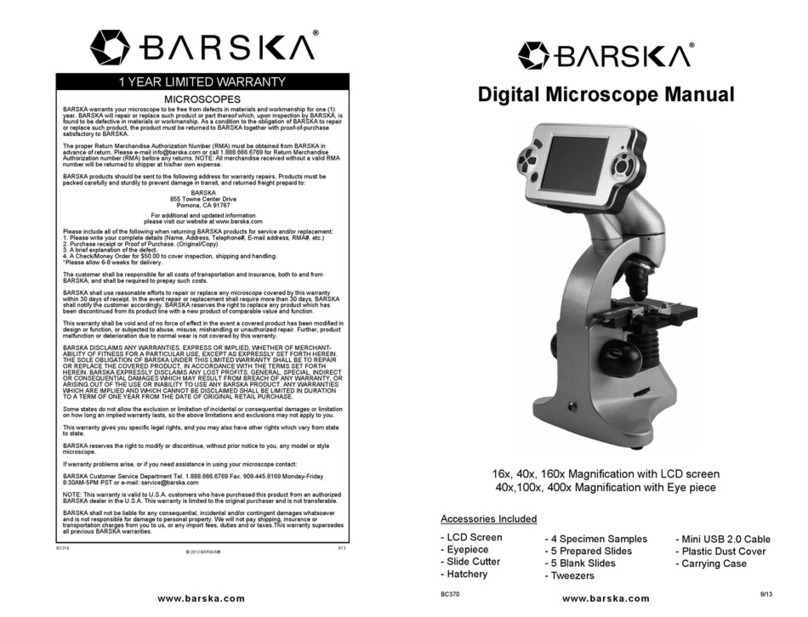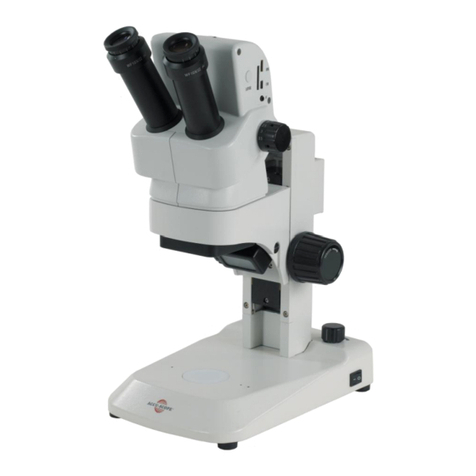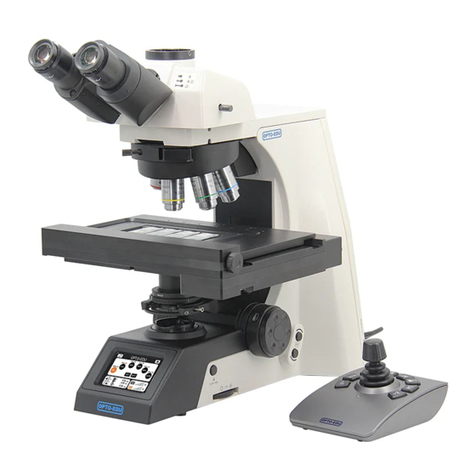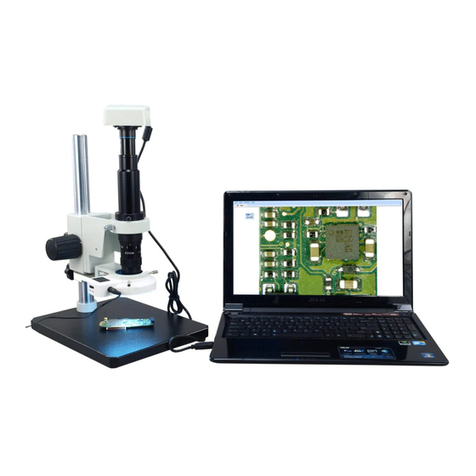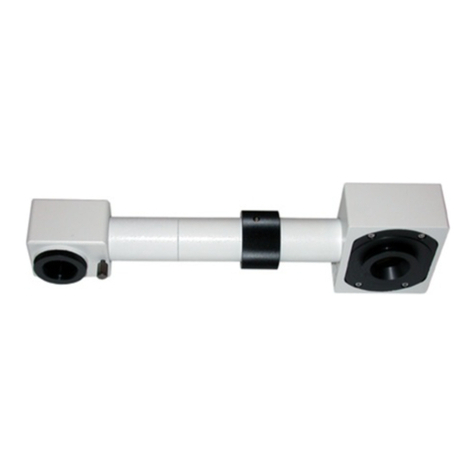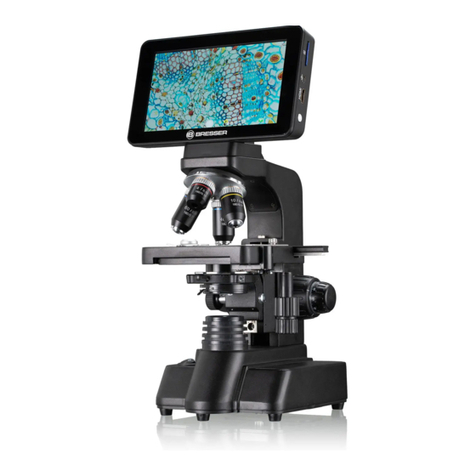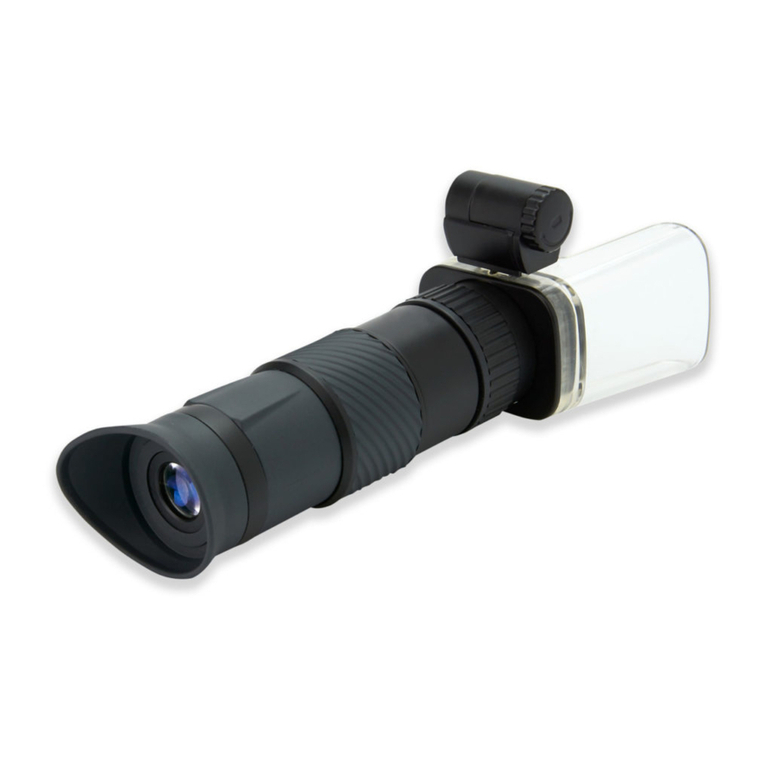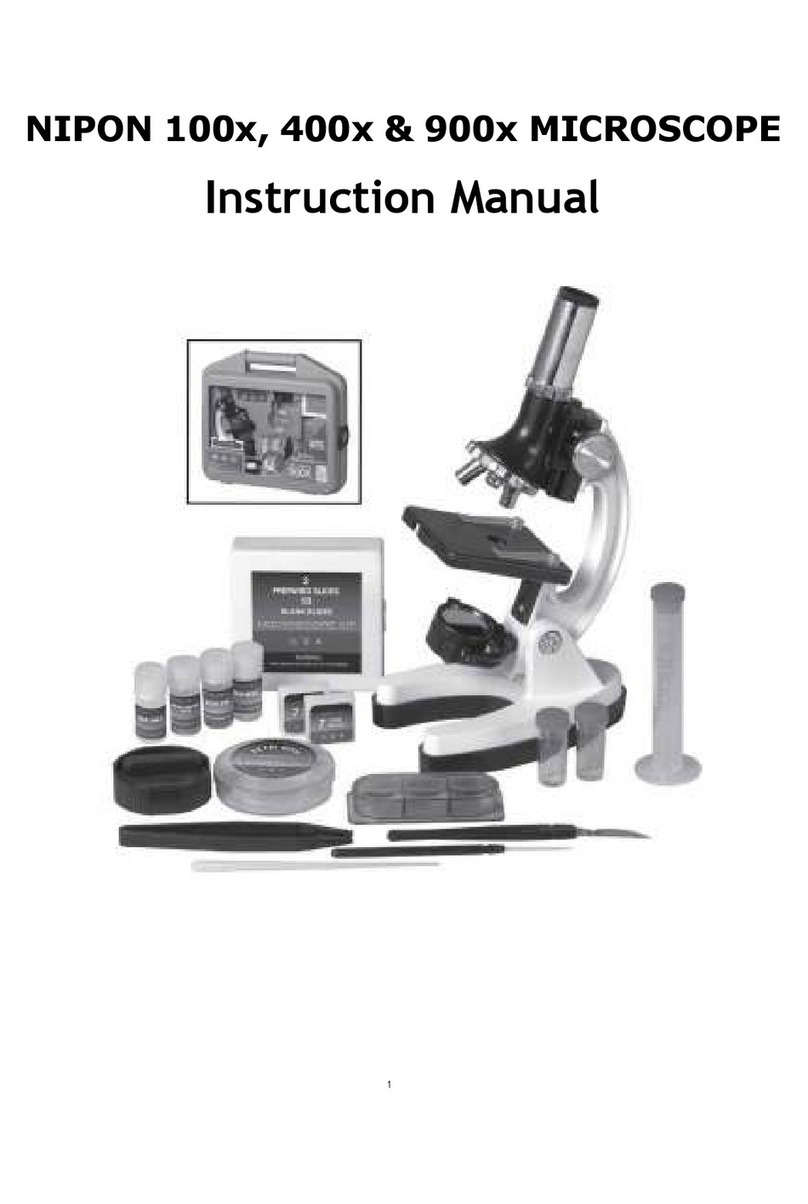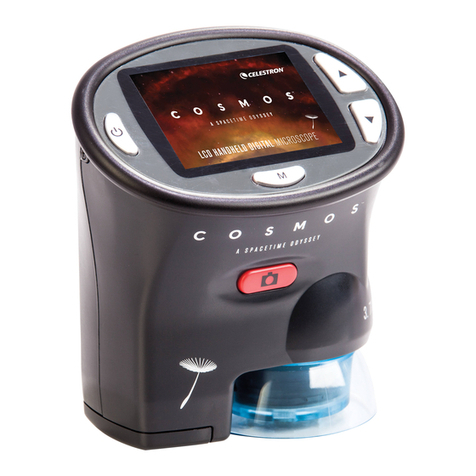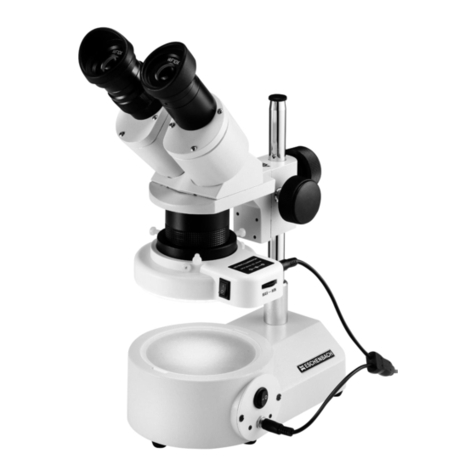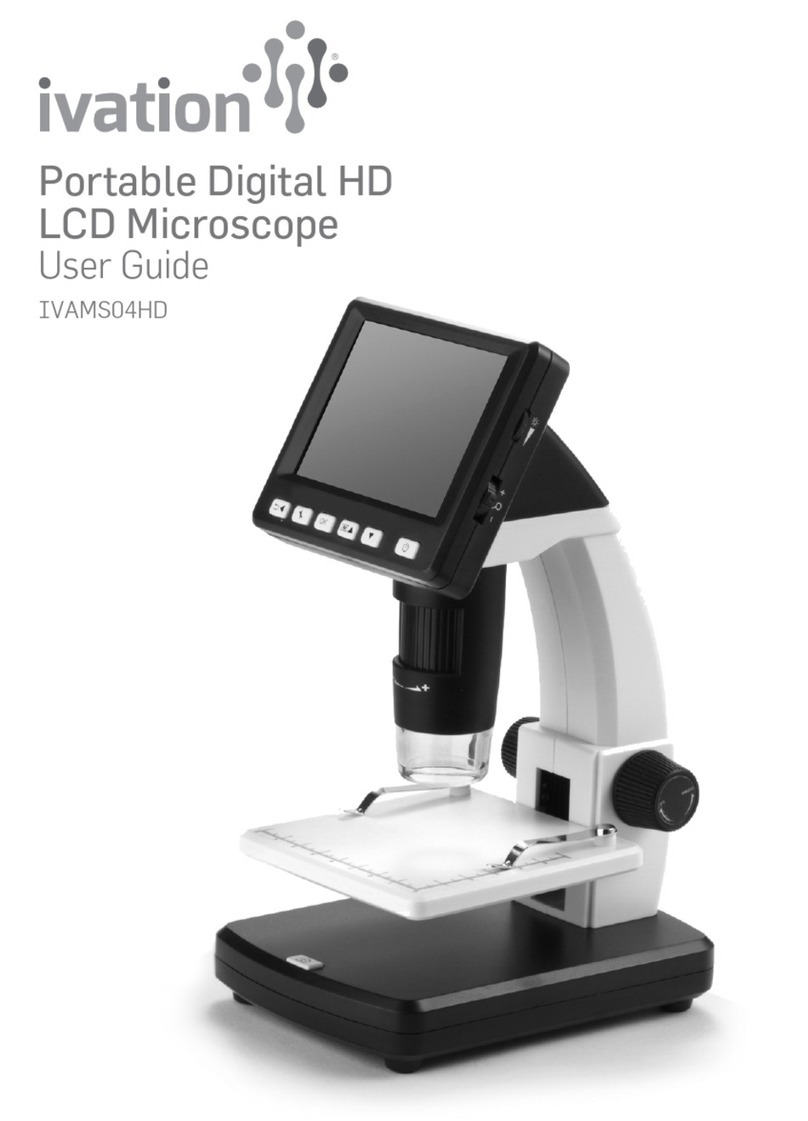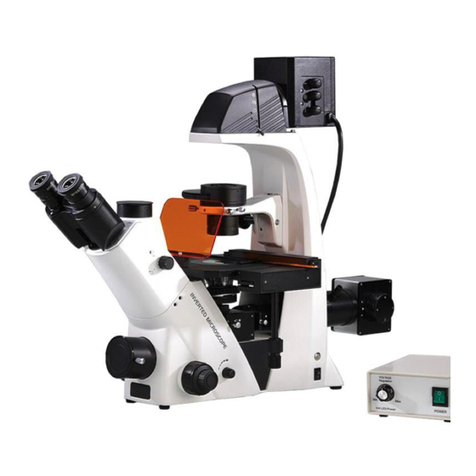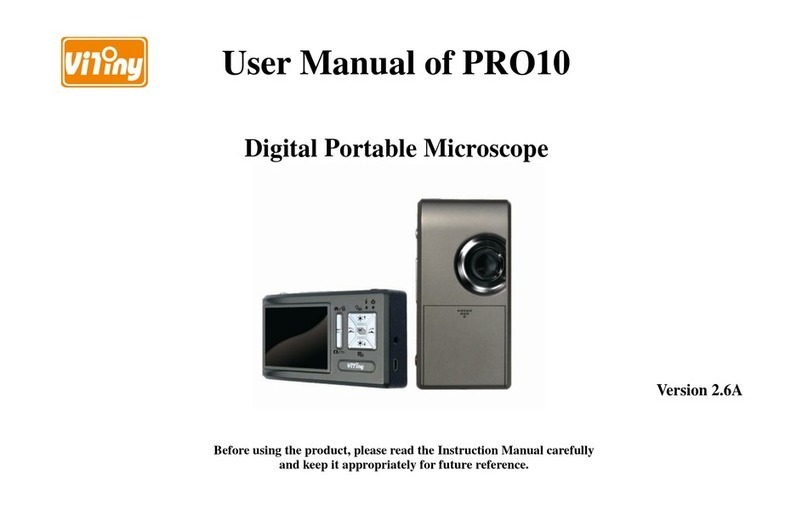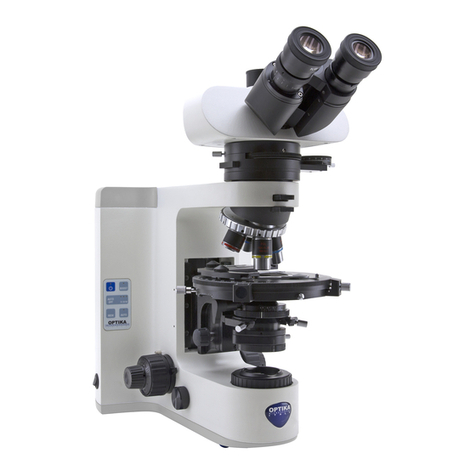Rodenstock Z Series User manual

RSL 4300/4500
SLIT LAMP
OPERATOR MANUAL
Z Series

1 EN
SLIT LAMP RSL 4300/4500 by RODENSTOCK
CONTENTS
1. INDICATIONS FOR USE ........................................................................................ 3
2. SAFETY................................................................................................................. 3
2.1 PHOTOTOXICITY ............................................................................................................................3
2.2 WARNINGS AND CAUTIONS..........................................................................................................4
2.3 CONTRAINDICATION.....................................................................................................................5
3. CLEANING AND DISINFECTION INSTRUCTIONS.................................................... 6
4. NAMES OF CONTROLS AND COMPONENTS ......................................................... 6
5. ASSEMBLY............................................................................................................ 8
5.1 TABLE TOP AND BASE ASSEMBLY PROCEDURE...............................................................................8
5.2 ILLUMINATION TOWER ASSEMBLY PROCEDURE.............................................................................9
5.3 CABLE ATTACHMENT PROCEDURE ..............................................................................................10
5.4 FITTING APPLANATION TONOMETERS, T TYPE AND R TYPES.........................................................11
6. INSTRUCTIONS FOR USE .................................................................................... 12
6.1 SETTING THE BINOCULARS..........................................................................................................12
6.2 PREPARING THE PATIENT AND USING THE SLIT LAMP ..................................................................13
6.3 DESCRIPTION OF FILTERS, APERTURES AND MAGNIFICATIONS.....................................................14
7. ROUTINE MAINTENANCE ................................................................................... 15
7.1 LED SYSTEMS ..............................................................................................................................15
7.2 REGULARLY INSPECT THE DEVICE FOR DAMAGE OR DIRT............................................................15
7.3 CLEANING THE ILLUMINATION PRISM .........................................................................................15
7.4 ELECTRICAL CONNECTIONS ........................................................................................................15
7.5 OPTICS........................................................................................................................................15
7.6 AXLE AND MECHANICAL PARTS..................................................................................................15
8. WARRANTY ........................................................................................................ 15
9. SPECIFICATIONS AND ELECTRICAL RATINGS...................................................... 16
9.1 ELECTROMAGNETIC EMISSIONS..................................................................................................16
9.2 ELECTROMAGNETIC IMMUNITY ..................................................................................................16
9.3 RECOMMENDED SAFE DISTANCES ..............................................................................................18
9.4 TECHNICAL SPECIFICATIONS .......................................................................................................19
10. ACCESSORIES AND SPARES................................................................................ 21
11. PACKAGING AND DISPOSAL INFORMATION....................................................... 22

2 3
EN EN
SLIT LAMP RSL 4300/4500 by RODENSTOCK SLIT LAMP RSL 4300/4500 by RODENSTOCK
Consult instructions for use General warning sign
Date of manufacture Warning: Electricity
Manufacturer’s name and
address Warning: Floor level obstacle
Country of manufacture Warning: Non-ionizing
radiation
Waste Electrical and Electronic
Equipment (WEEE) recycling Warning: Optical radiation
This way up Warning: Hot surface
Keep dry Conformité Européene
Fragile Type B applied part
Do not use if package is
damaged Class II equipment
Temperature limit Atmospheric pressure
limitation
Authorised representative in
the European Community Humidity limitation
Catalogue number Serial number
Translation Medical device
The Rodenstock Slit Lamp is designed and built in conformity with Directive 93/42/EEC, Regulation (EU) 2017/745
and ISO 13485 Medical Devices Quality Management Systems.
Classification: CE: Class I
FDA: Class II
The information contained within this manual must not be reproduced in whole or part without the manufacturer’s
prior written approval. As part of our policy for continued product development we the manufacturer reserve the right
to make changes to specifications and other information contained in this document without prior notice.
This IFU is also available on the Rodenstock website.
Copyright © Rodenstock Instruments 2021. Published in the UK 2021.
1. INDICATIONS FOR USE
This device is intended to be used only by suitably trained and authorised healthcare
professionals.
CAUTION: Federal Law restricts this device to sale by or on the order of a
physician or practitioner.
Intended use / purpose of instrument
The Rodenstock Slit Lamp facilitates an examination of the anterior segment, or frontal
structures and posterior segment, of the human eye, which includes the eyelid, sclera,
conjunctiva, iris, natural crystalline lens and cornea.The binocular slit-lamp provides
stereoscopic magnified view of the eye structures in detail, enabling anatomical diagnoses to
be made for a variety of eye conditions.
Brief description of the instrument
This Rodenstock Slit Lamp can either be mounted onto a custom table top supplied by Rodenstock
or can be mounted on a third party’s table top (refraction unit) by suitably trained technicians.
The Rodenstock Slit Lamp consists of 5 assemblies; Illumination Tower; Observation System; XYZ
Translation Base; Chinrest Assembly and a Table Top with Power Supply and Accessory Drawer.
The light intensity is controlled by a variable rheostat located on the XYZ Translation Base.
There are a number of selectable filters allowing the user to control the characteristics of the
examination light. Many ophthalmic instruments illuminate the eye with intense light. The light
intensity on the Rodenstock Slit Lamp is continuously adjustable from maximum to zero.
2. SAFETY
2.1 PHOTOTOXICITY
CAUTION: The light emitted from this instrument is potentially hazardous.
The longer the duration of exposure, the greater the risk of ocular
damage. Exposure to light from this instrument when operated at
maximum intensity will exceed the safety guideline after 81 seconds.
While no acute optical radiation hazards have been identified for slit
lamps, we recommend keeping the intensity of the light reaching the
patient’s retina to the minimum possible for the respective diagnosis.
Children, people with aphakia and people suffering from eye conditions
are most at risk. An increased risk may also occur if the retina is exposed
to the same or a similar device with a visible light source within 24 hours.
This applies, in particular, if the retina has been photographed with a
flashbulb in advance.
Rodenstock Instruments shall on request, provide the user with a graph
showing the relative spectral output of the instrument.

4 5
EN EN
SLIT LAMP RSL 4300/4500 by RODENSTOCK SLIT LAMP RSL 4300/4500 by RODENSTOCK
2.2 WARNINGS AND CAUTIONS
Please note that the proper and safe functioning of our instruments is only guaranteed if
both the instruments and their accessories are exclusively from Rodenstock Instruments.
The use of other accessories may result in increased electromagnetic emissions or reduced
electromagnetic immunity of the device and may lead to incorrect operation.
Observe the following prescriptions in order to ensure safe operation of the instrument.
WARNINGS
• Never use the instrument if visibly damaged and periodically inspect it for signs of damage
or misuse.
• Check your Rodenstock product for signs of transport / storage damage prior to use.
• Do not use in the presence of flammable gases / liquids, or in an oxygen rich environment.
• US Federal Law restricts this device to sale by or on the order of a physician or practitioner.
• This device is intended to be used only by suitably trained and authorised healthcare
professionals.
• This product should not be immersed in fluid.
• Repairs and modifications to the instrument must be made only by the specialized
technicians of the manufacturer’s Technical Service Centre or by personnel trained and
authorised by the manufacturer. The manufacturer declines any and all responsibility for
loss and/or damages resulting from unauthorised repairs; furthermore, any such actions
will invalidate the warranty.
• The power switch and mains plug are the means of isolating the device from the mains
supply – ensure both the power switch and mains plug are accessible at all times.
• Do not position the equipment so that is difficult to press the power switch or remove the
mains plug from the wall socket.
• Refraction stand variants or adaptors should only be used in combination with EN/IEC
60601-1 and EN/IEC 60601-1-2 compliant power supplies and devices.
• Route power cords safely to eliminate risk of tripping or damage to user.
• Before any cleaning of the instrument or the base unit ensure the power lead is
disconnected.
• LEDs can reach high temperatures in use – allow to cool before handling.
• Do not exceed maximum recommended exposure time.
• Should the instrument suffer shocks (for example, should it accidentally fall), and the
optical system or the illumination system are damaged it may be necessary to return the
instrument to the manufacturer for repair.
• After removal of the LED, do not touch the Slit Lamp LED electrical contacts and patient
simultaneously.
• The owner of the instrument is responsible for training personnel in its correct use.
• Ensure the instrument or instrument table is placed on a level and stable surface.
• Use only genuine Rodenstock approved parts and accessories or device safety and
performance may be compromised.
• Shut down after every use. In case the dust cover is used: risk of overheating.
• For indoor use only (protect from moisture).
• Electrical equipment can be affected by electromagnetic interference, for example
videostream may freeze for one minute or more. If this occurs whilst using this equipment,
switch the unit off and reposition. Essential performance is determined as continuous
videostream which cannot be interrupted for longer than one minute.
• Do not touch accessible connectors and the patient simultaneously.
• The Rodenstock Slit Lamp should not be used adjacent to or stacked with other equipment.
If adjacent or stacked use with other equipment is
• Necessary, the Rodenstock Slit Lamp should be observed/monitored to verify normal
operation in the configuration in which it will be used.
• The Rodenstock Slit Lamp cannot be used in the vicinity of sources known to cause
electromagnetic disturbance (magnetic resonance imaging, computed tomography,
radio-frequency identification, metal detectors, electronic article surveillance and other
electromagnetic security systems). Do not bring the Rodenstock digital Slit lamp into
magnetic resonance environment.
Before use, the Slit Lamp should be allowed to adjust to the ambient
room temperature for several hours. This is especially important when the
unit has been stored or transported in a cold environment; this can cause
severe condensation to develop on the optical elements.
2.3 CONTRAINDICATION
There is no restriction to patient population this device can be used with other than those
outlined in the contra-indications stated below.
Slit lamps can produce discomfort in some photophobic patients due to the high illumination.
Additionally patients must be co-operative and capable of sitting upright for the duration of
the examination, therefore the technique may not be suitable for patients who are unable to sit
upright for long periods of time or those with limited neck and back mobility.

6 7
EN EN
SLIT LAMP RSL 4300/4500 by RODENSTOCK SLIT LAMP RSL 4300/4500 by RODENSTOCK
RODENSTOCK SLIT LAMP
8. Eyepiece assembly securing knob
9. Yellow filter knob (up = out)
10. Illumination prism
11. Slit offset by rotating prism housing
12. Filter control wheel
13. Slit rotation knob
14. Slit width control knob
15. Aperture control wheel
16. Test bar & tonometer plate hole and cover
17. Illumination arm locking knob
18. Microscope arm locking knob
19. Diffuser
20. Joystick base locking knob
21. Joystick control (X Y Z movement)
22. Illumination control rheostat
23. Axle
24. Runner covers
25. Z type tonometer mounting hole
26. Yellow filter knob (up = out)
27. Lock for securing magnification body
28. Magnification change drum
29. Eyepieces – adjustable for PD and dioptre correction
30. Breath shield securing knob
21
22
23
24
25
28
27
29
30
26
20
3. CLEANING AND DISINFECTION INSTRUCTIONS
Before any cleaning of the instrument or the base unit, ensure the power
lead is disconnected.
Only manual non-immersion cleaning as described should be used for this instrument. Do not
autoclave or immerse in cleaning fluids. Always disconnect power supply from source before
cleaning.
1. Wipe the external surface with a clean absorbent, non-shedding cloth dampened with
de-ionised water / detergent solution (2% detergent by volume) or water / isopropyl
alcohol solution (70% IPA by volume). Avoid optical surfaces.
2. Ensure that excess solution does not enter the instrument. Use caution to ensure cloth is
not saturated with solution.
3. Surfaces must be carefully hand-dried using a clean non- shedding cloth.
4. Safely dispose of used cleaning materials.
4. NAMES OF CONTROLS AND COMPONENTS
Headrest Assembly
1. Fixation light cable
2. Forehead rest band
3. Patient’s eye height marker
4. Fixation light
5. Chinrest
6. Chinrest height adjuster
7. Patient grab handles
5
3
4
1
2
7
6
13
14
15
8
16
17
18
19
11
10
12
9
21
22
23
24
25
28
27
29
30
26
20

8 9
EN EN
SLIT LAMP RSL 4300/4500 by RODENSTOCK SLIT LAMP RSL 4300/4500 by RODENSTOCK
2. Using the wrench provided, fit the headrest assembly to the tabletop using the hex bolts
and washers. The headrest assembly locates on the underside of the tabletop. Take care
not to over tighten the hex bolts.
3. Attach the patient grab handles (7) to the headrest assembly.
4. Place the Slit Lamp base on the runners. Ensure that the wheels are in line with each
other. Check that the guide wheels are tight.
5. Fit the runner covers to the runners by gently sliding them inwards, towards each other.
5.2 ILLUMINATION TOWER ASSEMBLY PROCEDURE
1. Remove the hex bolt (a) from the base of the Illumination tower, and then place the
illumination tower on the Slit Lamp base with the base notch (b) and pin (c) aligned.
Attach the tower to the base using the hex bolt removed earlier and tighten using the
wrench provided.
2. Carefully fit the microscope body to the arm – ensuring it is pushed to the stop. Tighten
using the securing knob on the side.
a
b
c
slide to stop and secure
31. Main power switch
32. Power supply unit
33. Glide plate
5. ASSEMBLY
Your Rodenstock Slit Lamp has been designed to fit on to an electric insulated medical table base
or on to an electric insulated and fire resistant medical table top, e.g. a refraction stand or combi
unit.
Take care when unpacking your Slit Lamp that you do not accidentally damage or discard any
of the contents.
Leave the Slit Lamp in the packing for several hours after delivery before
unpacking to reduce the risk of condensation forming.
Rodenstock Slit Lamps can be fitted to most Refraction Stands / Combi units. Rodenstock
advises that this shall be carried out by a suitably trained technicians to ensure performance
and safety are not affected.
The refraction stand, combi unit or table leg must be IEC 60601-1
compliant.
If you are fitting or have fitted your Slit Lamp to a medical or Rodenstock table leg / base
ensure it is situated on a firm and level floor.
If the table leg / base has castors ensure the following before moving it to another location:
1. The table is at its lowest position.
2. The power cord is removed.
3. The Slit Lamp arm and base locking knobs are tightened.
4. The runner covers are securely located.
5. The system is moved by grasping it at its lowest practical point.
5.1 TABLE TOP AND BASE ASSEMBLY PROCEDURE
1. Attach the Slit Lamp table top to your table leg using the M6 x 20mm screws and
washers. Note that the power supply and accessory drawer should face the operator.
The security of the fitment of the table top to the table leg is critical for
patient and Slit Lamp safety
32
33
31
7Runners

10 11
EN EN
SLIT LAMP RSL 4300/4500 by RODENSTOCK SLIT LAMP RSL 4300/4500 by RODENSTOCK
3. Attach the breath shield as indicated in the images below.
5.3 CABLE ATTACHMENT PROCEDURE
1. Connect the power cables.
a) Chinrest fixation light cable to power supply unit.
b) (3 pin) cable from power supply unit to slit lamp base assembly.
c) (4 pin) main lamp cable from bottom of the illumination assembly to the slit lamp
base assembly.
d) Ensure cables are routed to allow free movement of the XYZ base and to be clear of
the patients.
If your Slit Lamp was not supplied with a transformer (Part #3020-P-5040),
make sure that the power connection is compatible with the specifications
in this manual and is connected by a qualified technician to an available
and suitable power supply, see section 9.4 Power Supply page 20.
2. If the Rodenstock Slit Lamp is used with a power supply or cables other than those
supplied, this may result in increased emissions or decreased immunity of the
Rodenstock Slit Lamp in relation to EMC performance.
3. Connect the mains power to the Slit Lamp transformer using the power lead provided.
4 pin
3 pin
3 pin to 3 pin
Fixation light socket
4. To isolate from the mains supply unplug the mains plug from the wall socket. Ensure
that the product is positioned so that it is easily accessible.
Only a hospital grade 3-conductor electrical power supply cable must be
used. For USA and Canada: Detachable power supply cord set, UL listed,
type SJE, SJT or SJO, 3-conductor, not smaller than 18 AWG. Plug, cable
and ground lead connection of the socket have to be in perfect condition.
5.4 FITTING APPLANATION TONOMETERS, T TYPE AND R TYPES
Rodenstock Applanation Tonometer (T-TYPE)
1. Position the guide plate in the tonometer/test bar support hole on the slit lamp.
2. Lift Tonometer out of the packaging and assemble it by inserting the pin on its base
into one of the two possible openings (for right or left eye) on the horizontal guide
plate above the slit lamp axis. These positions are related to the microscope optics and
observation can be made either through the right or the left eye-piece.
The tonometer will slip easily onto the support plate; stability is assured by the locking
pins.
3. To obtain an image as clear and as free of reflexes as possible, the angle between the
illumination and the microscope should be about 60° and the slit diaphragm should be
fully opened.
4. When not in use the Tonometer should be removed from the Slit Lamp and placed
securely back in the packaging or a suitable location.
Applanation Tonometer ‘Rodenstock Fixed’ (R-TYPE)
This instrument is for those who wish the tonometer to remain permanently on the slit lamp.
5. Mount the plate for the tonometer onto the microscope body using the securing screw.
6. Mount the Tonometer onto the mounting post ensuring the grub screws are loose.
7. Swing the Tonometer arm forward in front of the microscope for examination. Rotate
the Tonometer body until the prism is in the centre of the view through the eyepiece.
Carefully tighten the two retaining grub screws in turn until the Tonometer is secure on
the mount and the prism is in the centre of view.
Right eye
Left eye

12 13
EN EN
SLIT LAMP RSL 4300/4500 by RODENSTOCK SLIT LAMP RSL 4300/4500 by RODENSTOCK
8. To obtain an image as clear and as free of reflexes as possible, the angle between the
illumination and the microscope should be about 60° and the slit diaphragm should be
fully opened.
9. When not in use the tonometer arm should be swung up against the protection plate.
6. INSTRUCTIONS FOR USE
6.1 SETTING THE BINOCULARS
It is vital that the binoculars are optimised for the user’s optical
correction in order to obtain focused binocular images.
1. Remove the Test Bar locating hole cover plate (16) and place the test bar focus in the test
bar location hole at the base of the microscope arm.To access the location hole first remove
the cover. The test bar should be set with the flat projection face towards the Slit Lamp
Microscope. The illumination and the microscope should be in the zero degrees position.
2. Turn on the Slit Lamp and set the slit to full width (14), set the magnification to x16 (27).
3. Adjust the eyepieces pupillary distance by holding both eyepiece bodies and rotating
them inwards or outwards until they are correct for your PD.
4. Turn both eyepieces (28) to maximum plus (+)
correction.
5. Close one eye, and with the other eye look through
the microscope slowly turning the open eye
eyepiece towards the minus (-) position until the
image of the test bar is in focus. Stop.
6. Repeat the above process for the other eyepiece.
7. Make a note of the positions of the eyepieces so
that you can set them quickly if the Slit Lamp has been used by another clinician.
8. Note – younger examiners are recommended to compensate for their ability to accommodate
by further adjusting the eyepieces by minus one (-1) or minus two (-2) dioptres.
16
27
28
6.2 PREPARING THE PATIENT AND USING THE SLIT LAMP
Parts of the slit lamp coming in to contact with the patient should be
cleaned in accordance with these instructions prior to the examination.
Rodenstock recommends the use of disposable hygienic chinrest tissues
on the Chinrest before the patients place their chin on it.
Never use the instrument if visibly damaged and periodically inspect it for
signs of damage or misuse.
1. The patient should be as comfortable as possible and with the patient in the chinrest
adjust the chinrest height (6) so that the patient’s eyes are level with the height marking
(3) on the chinrest support.
2. Focus the eyepieces using the test bar as described earlier, and if you have not already
done so set them to your interpupillary distance by holding both eyepiece bodies and
rotating them inwards or outwards until they are correct for your PD.
3. Switch on the illumination, making sure the rheostat (21) is set to a low level to
minimise the patient’s exposure to light hazard.
4. Rotate the joystick (20) until the light beam is at eye level.
5. Holding the joystick vertical, move the slit Lamp base towards the patient until the slit
beam appears focused on the patient’s cornea.
6. Adjust slit width (14), magnification (27), slit rotation (13) and slit angle etc. as required
to perform the examination.
7. To offset the slit for sclerotic scatter or retro illumination, rotate the illumination prism
assembly (11) to the left or right as desired.
8. When using the blue filter (12) the user may wish to insert the yellow barrier filter (9).
The yellow barrier filter is out when the knob is up, in when it is down.
9. When the examination is complete, set the rheostat to a low level and switch off the Slit
Lamp.
Shut down after every use. In case the dust cover is used: risk of
overheating.
20
21
9
12
27
11
13
14
3

14 15
EN EN
SLIT LAMP RSL 4300/4500 by RODENSTOCK SLIT LAMP RSL 4300/4500 by RODENSTOCK
6.3 DESCRIPTION OF FILTERS, APERTURES AND MAGNIFICATIONS
Stereo microscope
Eyepieces 12.5x
Dioptric adjustment +/– 8D
PD range 8° converging eyepieces 49mm – 77mm
PD range 0° parallel eyepieces 38mm – 85mm
Convergent angle of optical axis 13°
Magnification change
5 step drum 3 step drum Magnification Field of view
3 5 6x 34mm
3 3 10x 22mm
3 3 16x 14mm
3 3 25x 8.5mm
3 5 40x 5.5mm
Filters
a) Clear
b) Neutral Density
c) Red Free
d) Blue
Apertures
Aperture diameters (mm)
a b c d
0.2 1 2 3 5 9 14 Reserved for
future use
7. ROUTINE MAINTENANCE
The maintenance outlined below should only be carried out once the
main power cable has been disconnected. If you have any problems that
are not covered by the procedures described below, contact Rodenstock
Instruments or your local supplier.
7.1 LED SYSTEMS
1. LED’s typically have a life exceeding 10,000 hours of continuous use and therefore can
be considered as a non-consumable item that will not require changing by a user.
2. Whilst this is a significant life expectancy, we suggest that the Slit Lamp is always
switched off between examinations to conserve energy and LED life.
3. In the unlikely event of an LED failure please contact Rodenstock or your local distributor
for guidance on the replacement procedure.
7.2 REGULARLY INSPECT THE DEVICE FOR DAMAGE OR DIRT
1. Routinely clean as per section 3 on page 6 cleaning instructions.
7.3 CLEANING THE ILLUMINATION PRISM
1. The prism should be cleaned with a soft, clean lens cloth.
2. Care must be taken to keep the objective and the eyepiece lenses clean – use only soft,
clean lens cloths to clean optical surfaces.
7.4 ELECTRICAL CONNECTIONS
1. Routinely check all electrical connections, cables and connectors.
7.5 OPTICS
1. The optics should be wiped clean of any loose dirt or debris with a suitable dust brush
then cleaned with a soft dry lens cloth, washed linen or other non abrasive lens cleaning
material.
7.6 AXLE AND MECHANICAL PARTS
If the Slit Lamp becomes hard to move on the glide plate, the plate should be cleaned with a
lightly oiled cloth or silicon polish. The axle should be cleaned only with dry lint free cloths.
8. WARRANTY
The Rodenstock Slit Lamps are guaranteed for two years against faulty workmanship materials
or factory assembly. Warranty is on a Return To Base (RTB) basis at the cost of the customer
and may be void if the Slit Lamp has not been regularly serviced.
The manufacturer’s warranty and terms and conditions are detailed on the Rodenstock website.
The mirror, main illumination lamp and general ‘wear and tear’ are excluded from our standard
warranty.

16 17
EN EN
SLIT LAMP RSL 4300/4500 by RODENSTOCK SLIT LAMP RSL 4300/4500 by RODENSTOCK
The manufacturer declines any and all responsibility and warranty
coverage should the instrument be tampered with in any manner or
should routine maintenance be omitted or performed in manners not in
accordance with these manufacturer’s instructions.
There are no user serviceable parts in this instrument. Any servicing
or repairs should only be carried out by Rodenstock Instruments or by
suitably trained and authorised distributors. Service manuals will be
available to authorised Rodenstock service centres and Rodenstock
trained service personnel.
9. SPECIFICATIONS AND ELECTRICAL RATINGS
The Rodenstock Slit Lamp is a medical electrical instrument. The instrument requires special
care concerning electromagnetic compatibility (EMC). This Section describes its suitability
in terms of electromagnetic compatibility of this instrument. When installing or using this
instrument, please read carefully and observe what is described here.
Portable or mobile-type radio frequency communication units may have an adverse effect on
this instrument, resulting in malfunctioning.
9.1 ELECTROMAGNETIC EMISSIONS
Guidance and manufacturer’s declaration – electromagnetic emissions
The Rodenstock Slit Lamp is intended for use in the electromagnetic environment specified
below. The customer or user should ensure that it is used in such an environment.
Emissions test Compliance Electromagnetic environment – guidance
RF emissions CISPR 11 Group 1 The Rodenstock Slit Lamp uses RF energy only for its
internal function. Therefore, its RF emissions are very low
and are not likely to cause any interference in nearby
electronic equipment.
RF emissions CISPR 11 Class B The Rodenstock Slit lamp is suitable for use in a
professional healthcare facility environment. The
Rodenstock Slit lamp is not intended for use in home
environment.
Harmonic emissions
IEC 61000-3-2
Class B
Voltage fluctuations /
flicker emissions IEC
61000-3-3
Complies
9.2 ELECTROMAGNETIC IMMUNITY
Guidance and manufacturer’s declaration – electromagnetic immunity
The Rodenstock Slit Lamp is intended for use in the electromagnetic environment specified
below. The customer or user should ensure that it is used in such an environment.
Immunity test IEC 60601 Test
level
Compliance
level
Electromagnetic
environment – guidance
Electrostatic
discharge (ESD).
IEC 6100-4-2
± 8 kV contact
± 15 kV air
± 8 kV contact
± 15 kV air
Floors should be wood, concrete
or ceramic tile. If floors are
covered with synthetic material,
the relative humidity should be at
least 30%
Electrical fast
transient/burst.
IEC 61000-4-4
± 2 kV for power
supply lines
± 1 kV for power
supply lines
± 2 kV for power
supply lines
N/A
Mains power quality should be
that of a typical professional
healthcare facility
Surge.
IEC 61000-4-5
± 1 kV line(s) to
line(s)
± 2 kV line(s) for
input/output line(s)
± 1 kV line(s) to
line(s)
± 2 kV line(s) for
input/output line(s)
Mains power quality should be
that of a typical professional
healthcare facility
Voltage dips, short
interruptions and
voltage variations
on power supply
input lines.
IEC 61000-4-11
UT= 0% 0.5 cycle
(0, 45, 90, 135, 180,
225, 270, 315°)
UT= 0%; 1 cycle
UT= 70%;
25/30 cycles (@ 0°)
UT= 0%;
250/300 cycle
UT= 0% 0.5 cycle
(0, 45, 90, 135, 180,
225, 270, 315°)
UT= 0%; 1 cycle
UT= 70%;
25/30 cycles (@ 0°)
UT= 0%;
250/300 cycle
Mains power quality should be
that of a typical professional
healthcare facility environment.
If the user of the Rodenstock
Slit Lamp requires continued
operations during power mains
interruptions, it is recommended
that the instrument be powered
from an uninterruptible power
supply.
Power frequency
(50/60 Hz)
Magnetic field. IEC
61000-4-8
30 A/m 30 A/m Power frequency magnetic fields
should be at a level characteristic
of a typical location in a typical
professional healthcare facility
environment.
Note: UTis the a. c. mains voltage prior to application of the test level.
Immunity
test
IEC 60601
Test level
Compliance
level
Electromagnetic environment
– guidance
Portable and mobile RF communications equipment
should be used no closer to any part of the
Rodenstock Slit Lamp, including cables, than the
recommended separation distances calculated from
the equation applicable to the frequency of the
transmitter.

18 19
EN EN
SLIT LAMP RSL 4300/4500 by RODENSTOCK SLIT LAMP RSL 4300/4500 by RODENSTOCK
Recommended separation distance
Conducted
RF IEC
61000-4-6
6 Vrms 1
50kHz to
80MHz
6 V d = 1.2 √ p
Radiated
RF IEC
61000-4-3
10 V/m 150kHz
to 280MHz
10 V/m d = 1.2 √ p 80MHz to 800 MHz
d = 2.3 √ p 800MHz to 2.7GHz
Where p is the maximum output power rating of the
transmitter in watts (W) according to the transmitter
manufacturer and d is the recommended separation
distance in metres (m).
Field strengths from fixed RF transmitters, as
determined by an electromagnetic site survey¹,
should be less than the compliance level in each
frequency range.²
Interference may occur in the vicinity of
equipment marked with this symbol.
Note: At 80MHz and 800MHz, the higher frequency range applies.These guide lines may not apply in all situations.
Electromagnetic propagation is affected by absorption and reflection from structures, objects and people.
1 Field strengths from fixed transmitters, such as base stations (cellular / cordless) telephones and land mobile
radios, amateur radio, AM and FM radio broadcast and TV broadcast cannot be predicted theoretically with
accuracy.To assess the electromagnetic environment due to fixed RF transmitters, an electromagnetic site survey
should be considered. If the measured field strength in the location in which the Rodenstock Slit Lamp is used
exceeds the applicable RF compliance level above, the Rodenstock Slit Lamp should be observed to verify normal
operation. If abnormal performance is observed, additional measures may be necessary, such as re-orientating or
relocating the Rodenstock Slit Lamp.
2 Over the frequency range 150kHz to 80 MHz, field strengths should be less than 10 V/m.
9.3 RECOMMENDED SAFE DISTANCES
Recommended separation distances between portable and mobile RF
communications equipment and the Rodenstock Slit Lamp
The Rodenstock Slit Lamp is intended for the use in an electromagnetic environment in
which radiated RF disturbances are controlled.The customer or the user of the Rodenstock
Slit Lamp can help prevent electromagnetic interference by maintaining a minimum distance
between mobile RF communications equipment (transmitters) and the Rodenstock Slit Lamp
as recommended below, according to the maximum output power of the communications
equipment.
Rated maximum output
power of transmitter (W)
Separation distance according to frequency of
transmitter (m)
150 kHz to 80MHz
d = 1.2√ p
80MHz to 800MHz
d = 1.2√ p
800MHz to 2.7GHz
d = 2.3√ p
0.01 0.12 0.12 0.23
0.1 0.38 0.38 0.73
1 1.2 1.2 2.3
10 3.8 3.8 7.3
100 12 12 23
For transmitters rated at a maximum output power not listed above, the recommended
separation distance din metres (m) can be determined using the equation applicable to the
frequency of the transmitter, where p is the maximum output power rating of the transmitter in
watts (W) according to the transmitter manufacturer.
Note: At 80MHz and 800MHz, the separation distance for the higher frequency applies.
These guidelines may not apply in all situations. Electromagnetic propagation is affected by absorption and
reflection from structures, objects and people.
9.4 TECHNICAL SPECIFICATIONS
Optical System
Type Galilean 8° converging | Galilean 0° parallel
Magnification Drum change x6, x10, x16, x25 & x40 | x10, x16 & x25
Eyepiece x12.5
Field of view 34, 22, 14, 8.5 and 5.5 mm | 22, 14 & 8.5mm
PD range 8° converging eyepieces, 49-77mm
0° parallel eyepieces, 38-85mm
Objective lens focal distance 107mm
Objective lens convergence angle 13°
Slit Projection System & Base
Slit Width 0-14mm continuously variable
Slit Length 14mm
Aperture diameters 0.2, 1mm square, 2, 3, 5, 9, 14 and reserved
Filters Clear; red free; neutral density; blue;
Slit rotation 360° continuous, detents at 0° and 180°
Base travel 25mm Z-axis, 107mm X-axis, 110mm Y axis

20 21
EN EN
SLIT LAMP RSL 4300/4500 by RODENSTOCK SLIT LAMP RSL 4300/4500 by RODENSTOCK
Horizontal fine adjustment 12mm
Table top dimensions 405 x 500mm
Fixation lamp LED
Light source LED
LED output power 240KLux (+/-20%)
Weight, packed (approx.)
Slit Lamp complete 25Kg, 90 x 58 x 45cm W x D x H
Protection against ingress IPxO
Class II ME equipment
Insulation between mains parts and the functional earth provide at least two means of protection.
Power Supply
Power supply unit Switch mode, (100V-240V input) +/- 10% multi plug compliant to EN/
IEC 60601-1 EN/IEC 61000-6-2, EN/IEC 61000-6-3
Fuse T2.5AH, 250V
Power supply output 12V DC: 2.5 amps must be EN/IEC 60601 compliant
Complies with Electrical Safety (Medical) EN/IEC 60601-1
Electromagnetic compatibility EN/IEC 60601-1-2
Ophthalmic instruments - Fundamental requirements and test methods
ISO 15004-1
Ophthalmic instruments - Optical radiation hazard ISO 15004-2
When the Slit Lamp is connected to the power supply together the constitute a Medical
Electrical System as defined in EN/IEC 60601-1:2006.
The power supply forms a part of ME equipment.
Fuse Ratings and Quantity
2.5 amp anti-surge
Fuse current 2.5A
Voltage rating V AC 250V
Breaking capacity 1500Amps
Blow characteristic: Time Delay
Environmental Conditions:
USE
35°C
10°C
90%
30%
1060 hPa
800 hPa
Shock (without packing) 10 g, duration 6 ms
STORAGE CONDITIONS
*50°C
-10°C
95%
10%
1060 hPa
700 hPa
TRANSPORT CONDITIONS
*50°C
-40°C
95%
10%
1060 hPa
500 hPa
Vibration, sinusoidal 10 Hz to 500 Hz: 0.5g
Shock 30 g, duration 6 ms
Bump 10 g, duration 6 ms
*This instrument does not meet the temperature requirements of ISO 15004-1 for storage and transportation. Do
not store or transport this instrument in conditions where the temperature may rise above 50 °C.
10. ACCESSORIES AND SPARES
Item Part Number
1.27mm A/F ALLEN KEY EP79-00766
1m DSL to PSU Cable 3020-P-7068
5mm L-Shaped Hexagonal Key EP79-10892
6mm L-Shaped Hexagonal Key EP79-10905
Black Patient Handle EP79-80070
Cable Clip EP39-80329
Chin Rest Pins (406) EP39-80321
Digital Base to Computer Cable 3020-P-7077

22
EN
SLIT LAMP RSL 4300/4500 by RODENSTOCK
Item Part Number
DSL Accessory Kit Packaging 3020-P-5221
DSL Digital Background Illum.Assy 3020-P-5039
DSL Digital Backlight Filters 3020-P-7054
DSL DIGITAL LEFT/RIGHT LABEL EP39-80365
DSL DIGITAL X-Y PAD EP39-80364
DSL Illum Projection Mirror-Small EP39-80250
DSL Refraction Stand Cable Kit 3020-P-7014
DSL Screw Kit 3020-P-5240
DSL Table Template EP39-80324
Dust Cover - No branding EP39-19072
Fixation&Illum to 6 Pin Connector 3020-P-7117
Linear Gear Rack (405) EP39-80173
Linear Gear Rack Cover/silver EP39-80174
Refraction Cable (XY-Bulb) 3020-P-7013
Rodenstock PSU 12V 3020-P-5040-ROD
USB3 Type-A to Micro-B Cable Assy 3020-P-7107
XY Pad (405) EP39-80169
11. PACKAGING AND DISPOSAL INFORMATION
Disposal of old electrical and electronic equipment
This symbol on the product or on its packaging and instructions indicates
that this product shall not be treated as household waste.
To reduce the environmental impact of WEEE (Waste Electrical Electronic
Equipment) and minimise the volume of WEEE entering landfills we
encourage at product end of life that this equipment is recycled and reused.
If you need more information on the collection reuse and recycling then please
contact B2B Compliance on 01691 676124 (+44 1691 676124). (UK only).
Any serious incident that has occurred in relation to the device must be reported
to the manufacturer and the competent authority of your Member State.

Contact
Manufacturer
Keeler Limited
Clewer Hill Road
Windsor
Berkshire
SL4 4AA UK
Freephone 0800 521251
Tel +44 (0) 1753 857177
Fax+44 (0) 1753 827145
EP59-51519 Issue 5 Date of Issue 12/05/2021
SUPPLIER
Rodenstock Instruments
Business Unit of Tomey GmbH
Wiesbadener Straße 21
90427 Nürnberg Germany
Tel +49 9131 777 1 777
Fax +49 9131 777 1 20
Visiometrics, S. L.,Vinyals, 131
08221 Terrassa, Spain
This manual suits for next models
2
Table of contents
Other Rodenstock Microscope manuals

